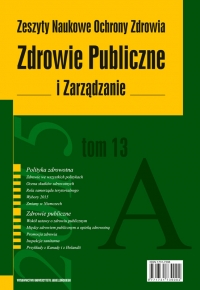Calls for Emergency Medical Service and Synoptic Conditions in Stargard Szczeciński Province
Calls for Emergency Medical Service and Synoptic Conditions in Stargard Szczeciński Province
Author(s): Czesław Koźmiński, Bożena Michalska, Dariusz MilczarekSubject(s): Recent History (1900 till today), Health and medicine and law
Published by: Wydawnictwo Uniwersytetu Jagiellońskiego
Keywords: accidents; emergency medical; illnesses; synoptic conditions;
Summary/Abstract: The assessment of weather conditions on days with registered calls for emergency medical service (EMS) was made with the use of weather charts at the level of 850 hPa, 00 UTC provided by the German Weather Service (www.wetterzentrale.de/topkarten/tkfaxbraar.htm). Synoptic situations on days with registered calls for EMS were categorized into 13 weather types according to the German Weather Service. This paper analyses the number of calls for EMS recorded on individual days in Stargard Szczeciński province in the period of 2008–2011 to people suffering from coronary heart disease, including myocardial infarction, mental disturbances (mainly schizophrenia), epilepsy, stroke, arterial hypertension, asthma and emergency- related ambulance trips as well as death. The number of calls registered in Stargard Szczeciński province in the period of 2008– 2011 amounted to more than 41 thousand, and the daily number ranged from 13 to 50 – the highest in March and January, lowest in September and October. From the analysed 13 weather types the following types were most predominant on days with calls for EMS: the center of low pressure area (type 6), cold air advection in the retral part of low pressure area (type 7), and lingering center of high pressure area (type 1, 2). 70–80% of the analysed days in a year were characterised by low pressure system and weather types connected with it: 4 (warm aid advection in the front part of low pressure area), 5 (warm sector of low pressure area), 6 (the center of low pressure area), 7 (cold air advection in the retral part of low pressure area); and high pressure system and weather types: 1 (high pressure center – no thermal inversions), 2 (high pressure center – thermal inversions), 11 (cold high pressure area), 12 (warm sector of high pressure). From the remaining 5 types of weather (3, 8, 9, 10, 13) occurring on days with calls for EMS, the following weather types were predominant: type 3 (air slips at the edge of high pressure area) – 10.1%, followed by type 8 (waving front zone) – 9.4%. Depending on the type of illness, the sensitivity of patients to changing meteorological conditions, expressed by the number of calls for EMS, varied during a year. People suffering from asthma and COPD required EMS help in summer on days with low pressure systems – 64.7%, and in winter during lingering high pressure areas – 33.3%. Epileptic seizures were more common in summer during the transition of low pressure systems – 63%, and in autumn during high pressure systems – 20% of days under study. The frequency of calls for EMS to people suffering from arterial hypertension was the highest in autumn and winter – approximately 57% each, during transition of low pressure areas, and in winter during lingering high pressure – 25.4%.
Journal: Zdrowie Publiczne i Zarządzanie
- Issue Year: 13/2015
- Issue No: 2
- Page Range: 194 - 203
- Page Count: 10
- Language: English

